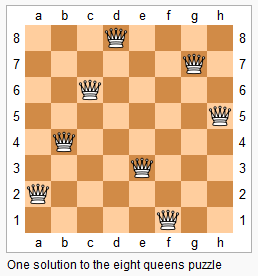LeetCode开心刷题二十七天——51. N-Queens
Bonus:
const修饰的i我们称之为符号常量。即,i不能在其他地方被重新赋值了。注意:const int i与int const i是等价的
- N-Queens
Hard
104047FavoriteShare
The n-queens puzzle is the problem of placing n queens on an n×nchessboard such that no two queens attack each other.

Given an integer n, return all distinct solutions to the n-queens puzzle.
Each solution contains a distinct board configuration of the n-queens’ placement, where 'Q' and '.' both indicate a queen and an empty space respectively.
Example:
Input: 4Output: [[".Q..", // Solution 1"...Q","Q...","..Q."],["..Q.", // Solution 2"Q...","...Q",".Q.."]]Explanation: There exist two distinct solutions to the 4-queens puzzle as shown above.This is a classic problem that has been bothering me for a long time,use back-tracing,finally Ican't finish it without looking the answer.SO this problem deverse repeated analysis and trialThe huahua's answer exchange the position of x and y,but I recovered in my answer!a#include<stdio.h>#include<iostream>#include<vector>#include<algorithm>#include<stack>#include<string>#include<memory>#include<memory.h>#include<hash_map>#include<map>#include<list>#include<set>#include<math.h>#include<unordered_map>using namespace std;class Solution {public:vector<vector<string>> solveNQueens(int n) {ans_.clear();tmp_=vector<string>(n,string(n,'.'));cols_=vector<int>(n,0);//row_=vector<int>(n,0);diag1_=vector<int>(2*n-1,0);diag2_=vector<int>(2*n-1,0);nqueens(n,0);for(auto i:ans_){for(auto j:i){cout<<j<<endl;}cout<<endl;cout<<endl;}return ans_;}private:vector<vector<string>> ans_;vector<string> tmp_;vector<int> cols_;//don't need row,we loop by row.it don't have chance duplicate//vector<int> row_;vector<int> diag1_;vector<int> diag2_;void nqueens(const int n,const int x){if(x==n){ans_.push_back(tmp_);return;}for(int y=0;y<n;y++){if(!available(x,y,n)) continue;put_(x,y,n,1);nqueens(n,x+1);put_(x,y,n,0);}}bool available(int x,int y,int n){return !cols_[y]&&!diag1_[x+y]&&!diag2_[x-y+n-1];}void put_(int x,int y,int n,bool is_put){cols_[y]=is_put;diag1_[x+y]=is_put;diag2_[x-y+n-1]=is_put;tmp_[x][y]=is_put?'Q':'.';}};int main(){Solution s;int n;cin>>n;s.solveNQueens(n);}
Bonus:
https://zhuanlan.zhihu.com/p/33090662
https://blog.csdn.net/mo_yihua/article/details/51627809
Two function to handle the input:
input() 除此外还可以接受表达式
raw_input() 读取一行,返回字符串
special Action:
Because these two functions can only handle string,so use these two methods to change it.
1.Forced type conservation
2.eval() function
a = input("请输入:")请输入:123>>> type(a)<class 'str'>a = int(input("请输入:"))请输入:123>>> type(a)<class 'int'>相当于整数赋值,eval帮我们去除了引号a = eval(input("请输入:"))请输入:123>>> type(a)<class 'int'>input([prompt]) 函数和 raw_input([prompt]) 函数基本类似,但是 input 可以接收一个Python表达式作为输入,并将运算结果返回。#!/usr/bin/python# -*- coding: UTF-8 -*-str = input("请输入:");print "你输入的内容是: ", str这会产生如下的对应着输入的结果:请输入:[x*5 for x in range(2,10,2)]你输入的内容是: [10, 20, 30, 40]
转载于 //www.cnblogs.com/Marigolci/p/11274267.html
//www.cnblogs.com/Marigolci/p/11274267.html



































还没有评论,来说两句吧...